Brand-new Houston Botanic Garden showcases tropical and subtropical plants – part 1
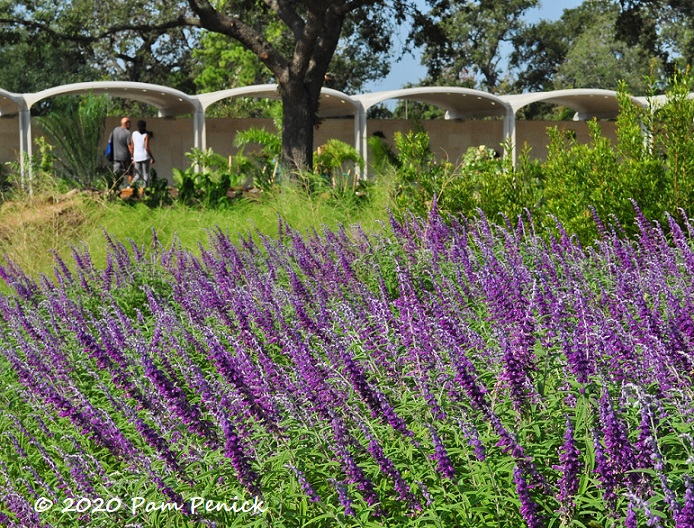
Austin, Dallas, Fort Worth, and San Antonio all have botanical gardens, but until now, the biggest and most international city in Texas did not. Last weekend Houston finally got its due with the long-anticipated opening of Houston Botanic Garden. I road-tripped with my daughter three hours east to Houston to check it out.
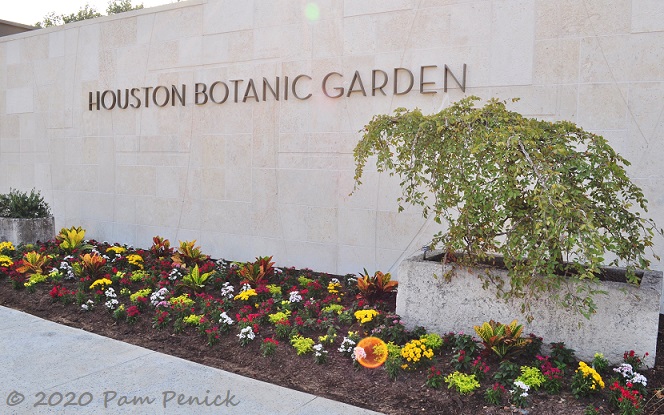
The garden occupies a former golf course in southeast Houston near Hobby Airport, embraced by Sims Bayou, one of the slow-moving channels that meander through flat, flood-prone Houston. The 132-acre garden’s 30-year master plan, according to Inhabitat, includes “conserving water, promoting biodiversity and providing habitat for butterflies, birds and other wildlife. Garden designers integrated the plans into the surrounding Sims Bayou, allowing for the flooding and intense weather events so prevalent in Houston.”
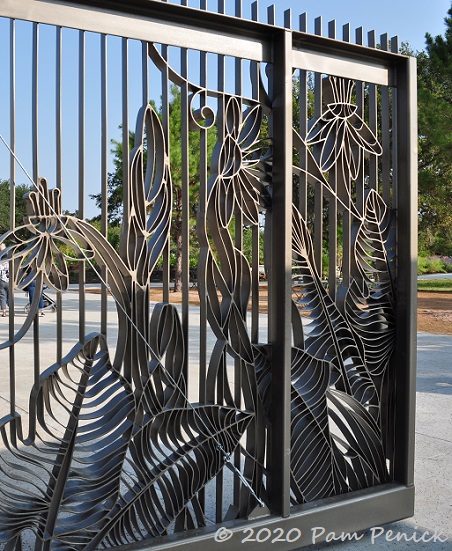
We arrived right at opening on Saturday, entering through floral-themed gates.
Pine Grove
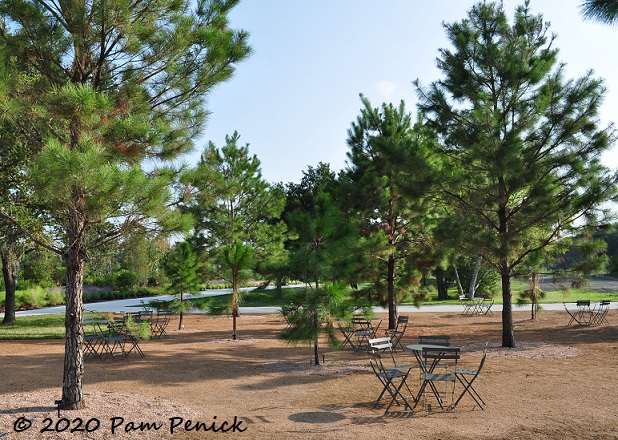
And hey, we’re not in Austin anymore, as evidenced by the pine trees of Pine Grove, one of many seating areas throughout the gardens. Some of the trees are already fairly large, but as they grow this space will eventually offer a shady, forest-like hangout right at the entrance. I like that it’s paved not with concrete but water-permeable decomposed granite.
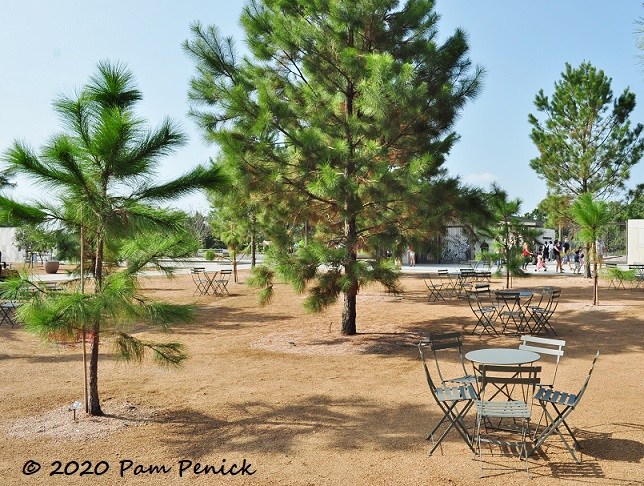
Slash pine (Pinus elliottii) on the left has long, feathery needles.
Welcome Fountain
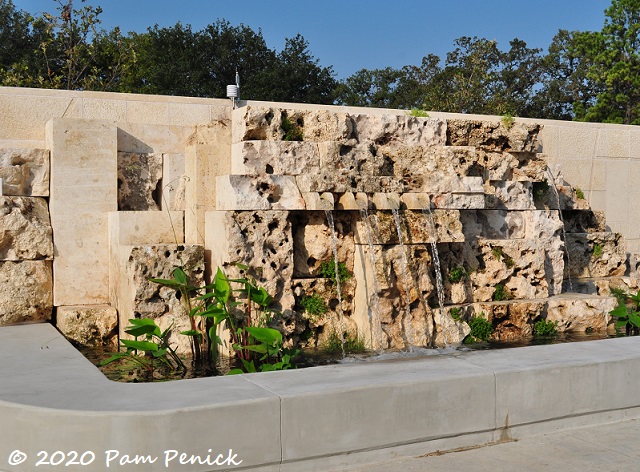
A wall fountain invites you into the garden. Water spills from four stone sluices into a narrow pool greened up with pond plants.
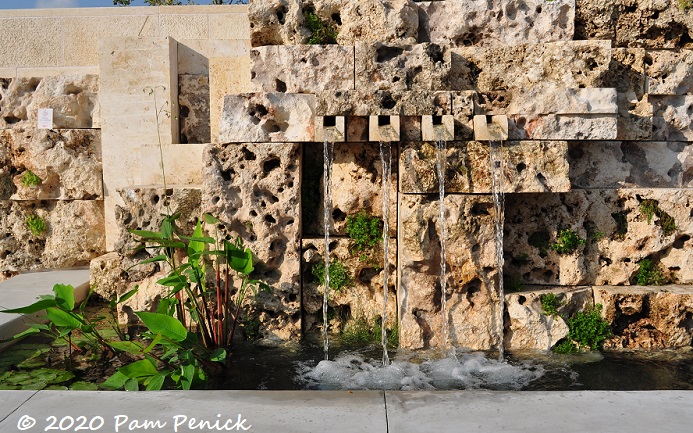
The holey rock, coral stone from the Dominican Republic, gives a tropical look.
Global Collection Garden
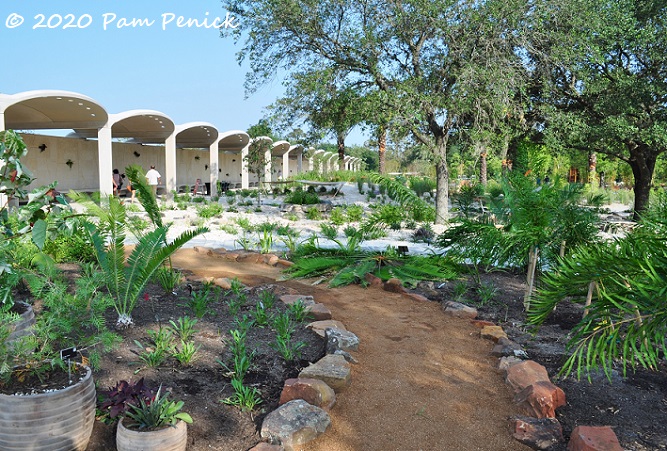
And then you enter the garden proper, where paths wind through newly planted beds of often quite exotic-looking plants. This is the Global Collection Garden, 3 acres of tropical, subtropical, and arid gardens with plants from all over the world that can be grown in Houston’s zone 9 humid subtropical climate.
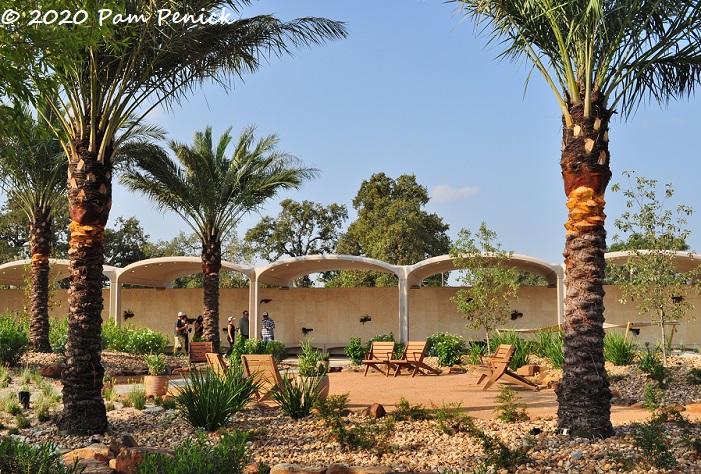
The fountain wall, in a bold architectural move, runs the length of this garden, shaded by an arching portico reminiscent of 1950s or ’60s Space Age Houston. I like it a lot.
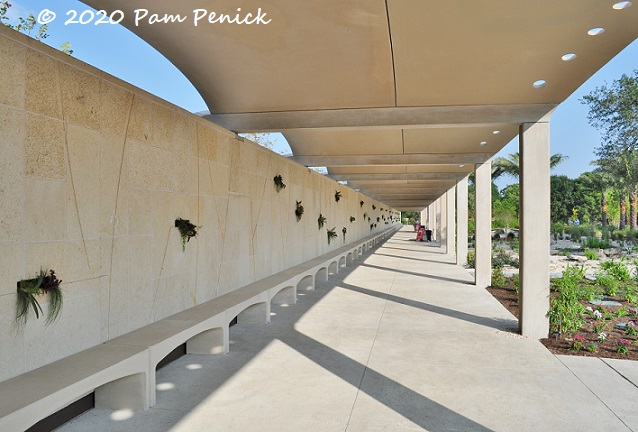
As anyone in Texas knows, shade is critical for much of the year when you’re outdoors. This arcade delivers. Extending the length of a football field, a bench runs all the way along the wall, inviting visitors to sit and look out over the garden. Punctuating the stone wall, plants tucked into narrow openings add color and texture and move the eye up and down.
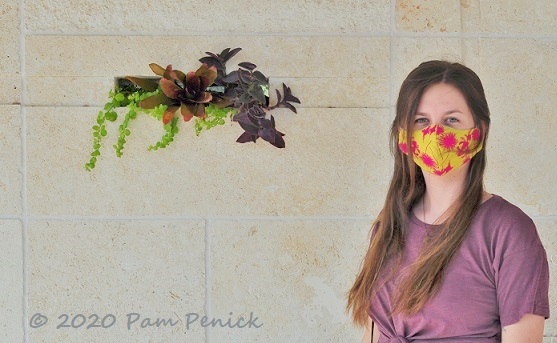
Wall bouquets!
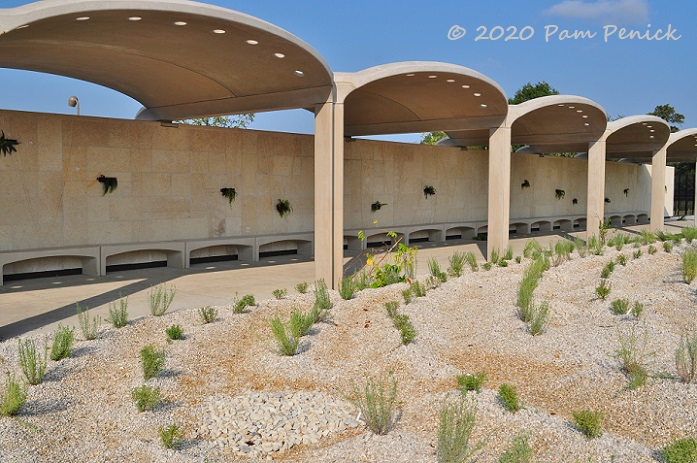
At one end, curved, gravelly berms are planted with xeric-looking plants. It’ll be interesting to come back and see how this space looks when the plants mature.
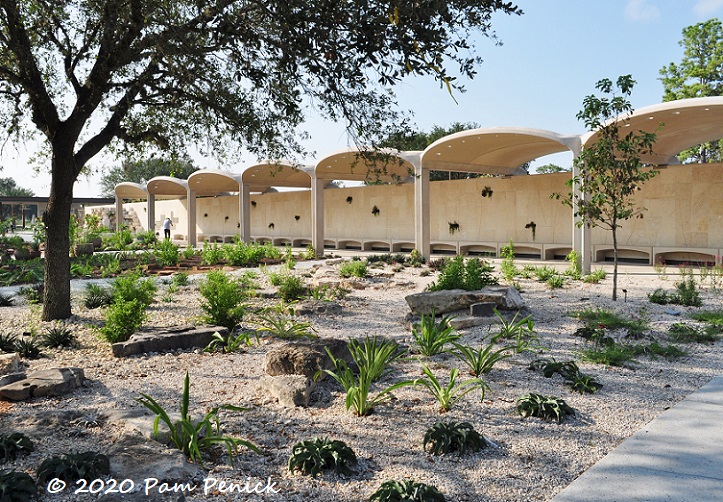
In another area, under the shade of a large tree, a collection of mangaves set my heart aflutter. Some seem to crawl across the ground like green spiders.
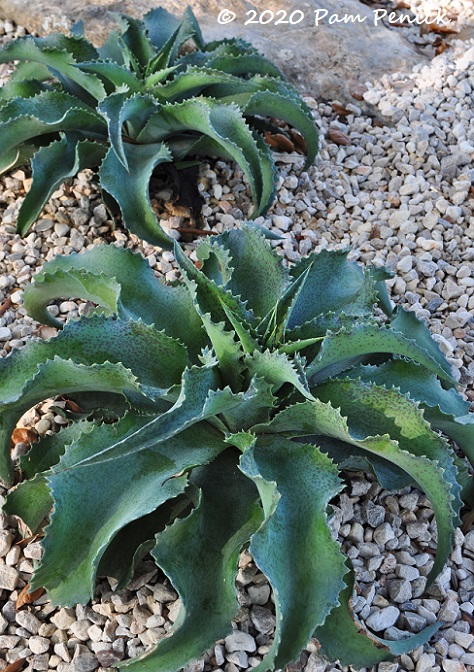
I covet this one, ‘Falling Waters‘ mangave.
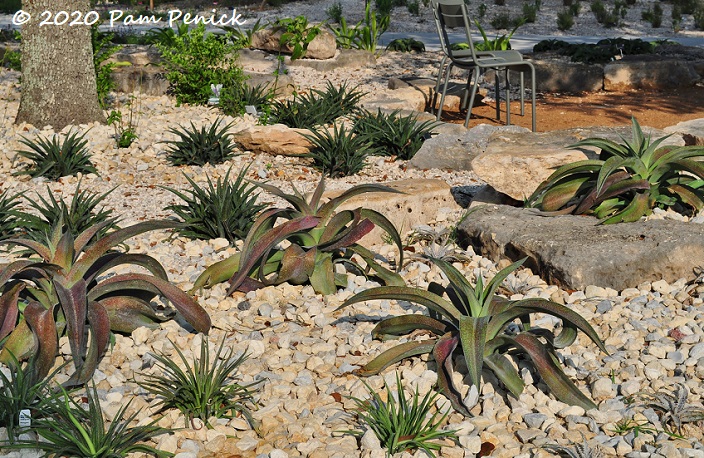
Purplish ‘Macho Mocha’ mangave, one of my faves. The smaller ones in front are ‘Bad Hair Day’ mangave.
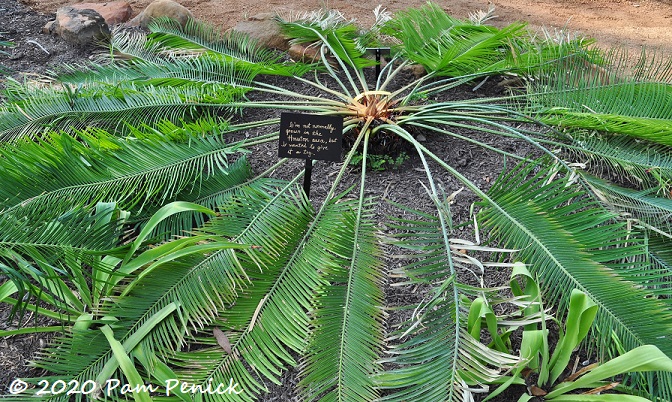
Uh-oh. One cycad lay as if stomped flat by an elephant.
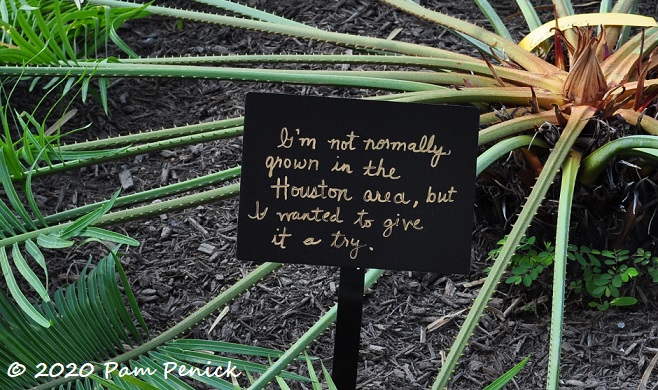
A sign explains, “I’m not normally grown in the Houston area, but I wanted to give it a try.” Right on! A botanical garden should be experimenting. I’ll be curious to see how the plantings change as the garden gets established.
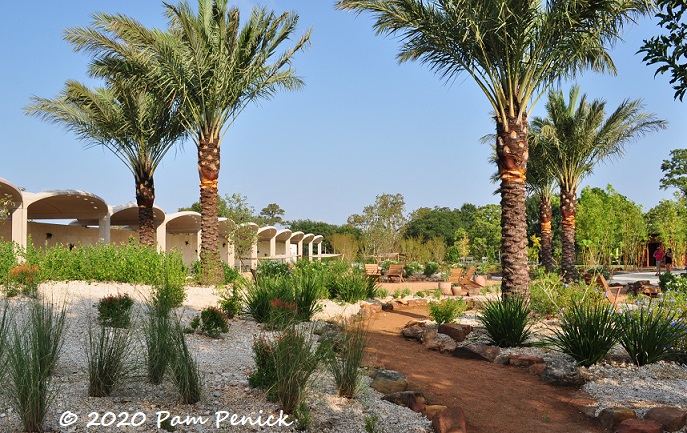
Although common throughout Houston, palms create a tropical vibe.
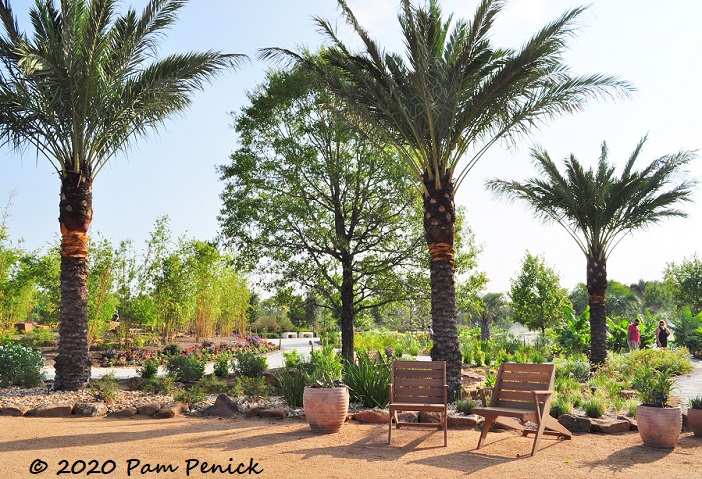
I really like the various seating areas in the garden, and comfortable seats too, not just benches. It reminds me of Chanticleer in that way. You’re invited to hang out and just be in the garden.
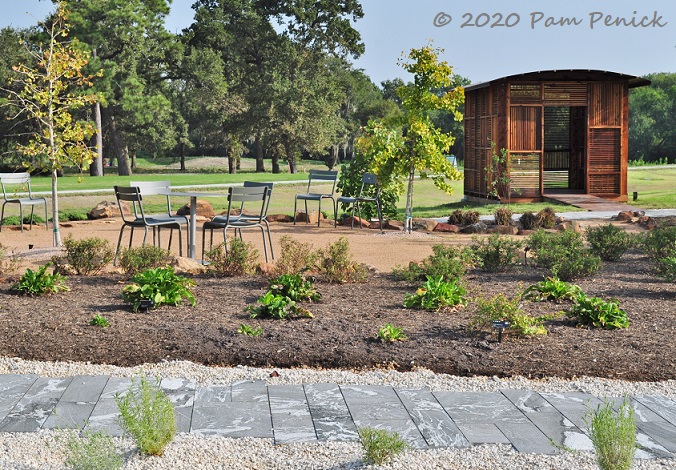
Another patio with tables and chairs. Off to one side stands a slatted, open-air structure, which the garden calls a “curiosity cabinet.”
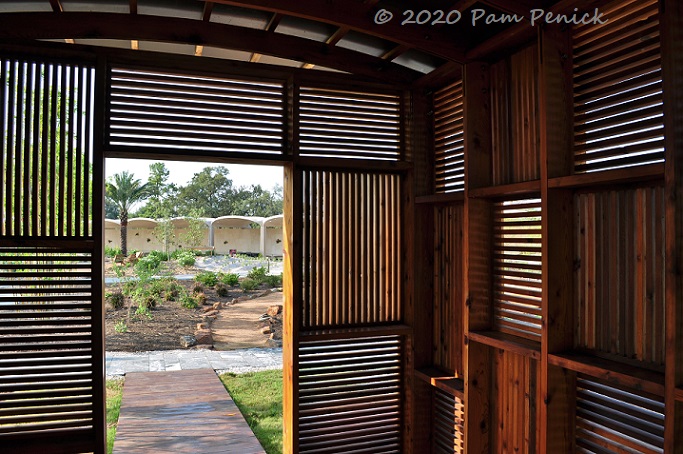
What’s it for? It looks like a shade structure, but there’s no seating inside. A low opening, low enough that you’d have to crawl through, exits out the back. A mystery.
Update 9/24: Justin Lacey, the garden’s director of communications, emailed me to explain (thanks, Justin!): “The Curiosity Cabinets will one day have hands-on learning opportunities in them (fun and unique natural items – like pine cones, palm fronds, etc. – that visitors of all ages can handle). And, although the one you photographed doesn’t yet have anywhere for the shorter, rear exit to go – that’s coming in a future phase of the Garden’s development – the one in the Upland Forest does have plantings on both ends. The shorter door is for our littler visitors.”
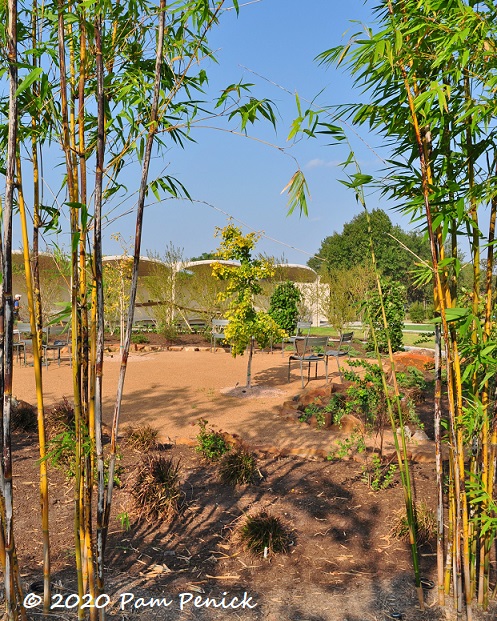
A gap in a bamboo screen allows a glimpse of a young ginkgo tree. One day, imagine — a tall, graceful ginkgo in golden autumn glory.
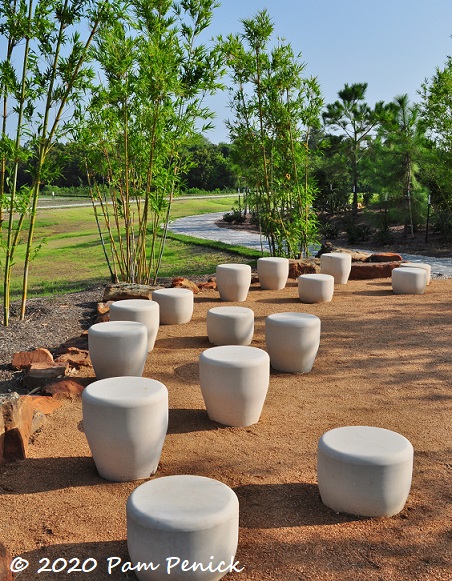
Another patio, this one with more than a dozen white stools resembling marshmallows. Cute!
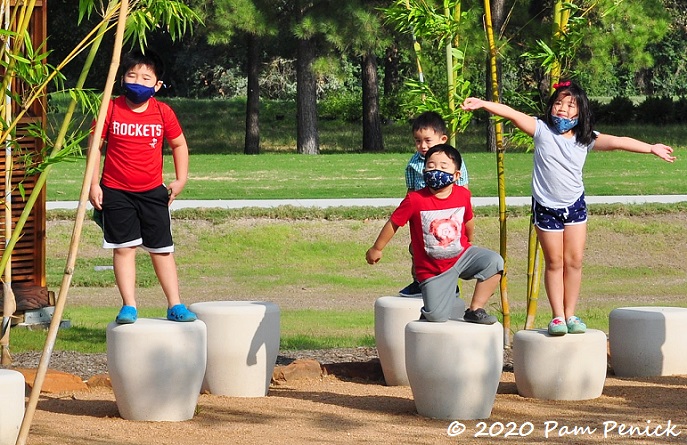
A few minutes later an adorable group of siblings posed on them for their mom as she snapped a photo.
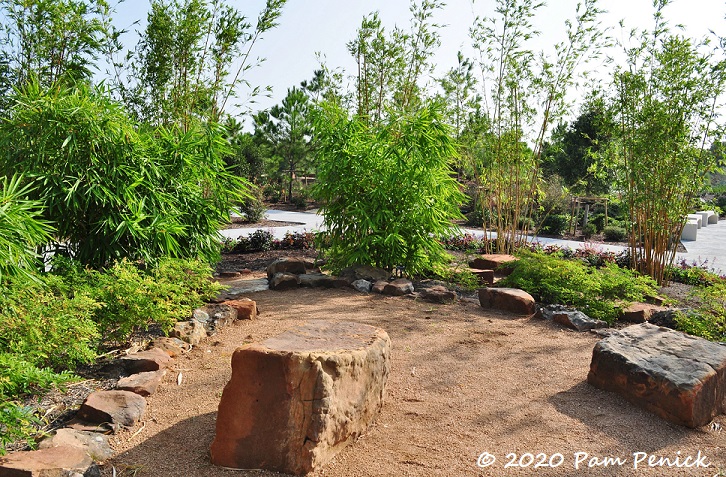
Houston is flat, flat, flat, but a number of low hills have been built up for interest — and drainage, presumably — with paths that wind to the top. At the center of this one, boulders provide a spot to sit amid the bamboo.
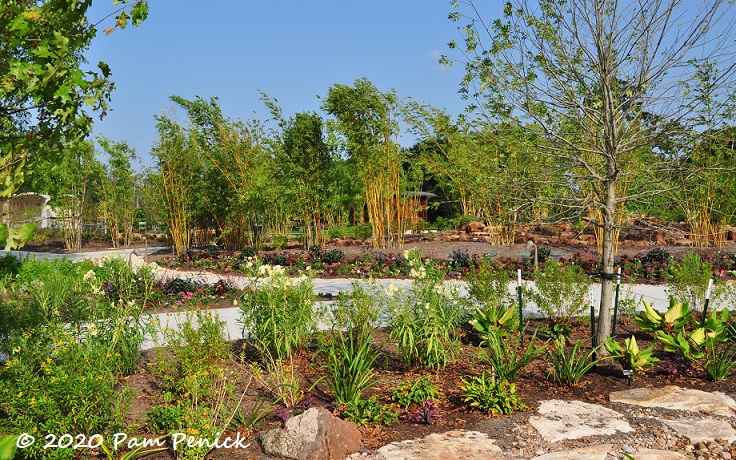
A long view shows the hillock of the bamboo garden (in the background).
Tropical Garden
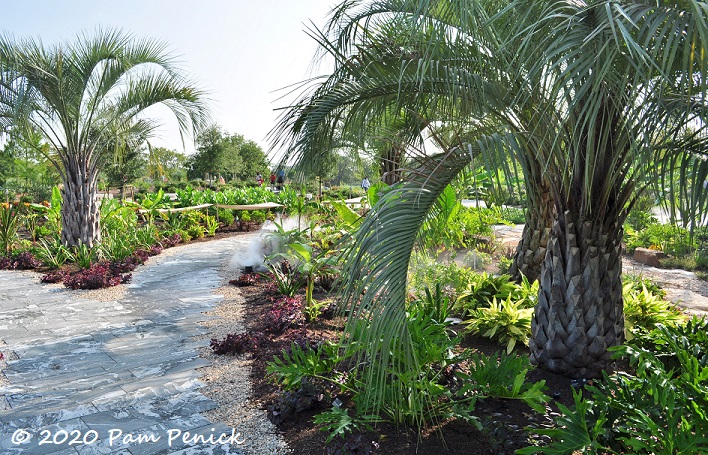
We followed a handsome stone path into a lush planting of palms, philodendron, colocasia, ginger, and spider lilies. Low clouds of mist issue from hidden emitters to create a rain forest effect. I was reminded of the mist machines in Hartman Prehistoric Garden at Austin’s Zilker Botanical Garden, which only worked for a short while before being turned off permanently. I’ll be interested to see if these last.
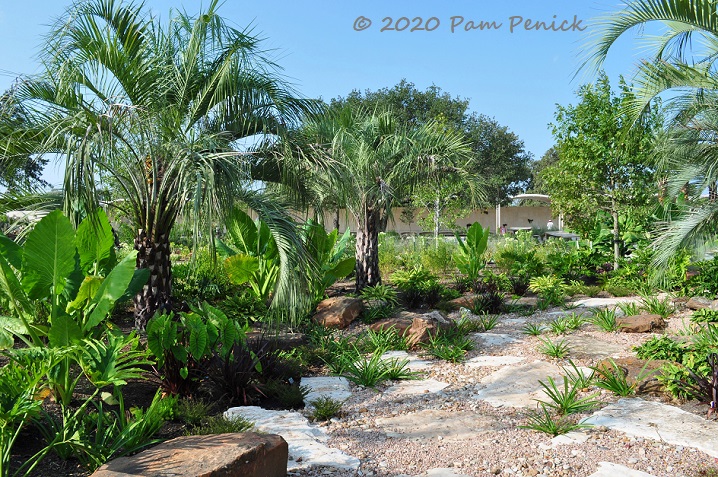
A side path of flagstone leads you on a more exploratory journey.
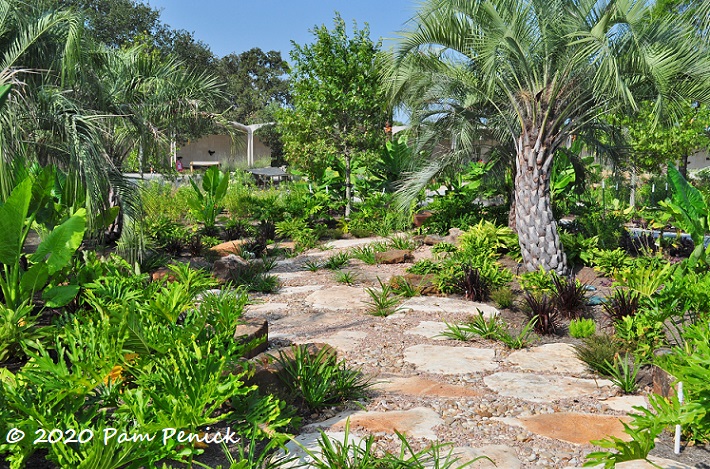
The plantings are so full already, considering how new this garden is.
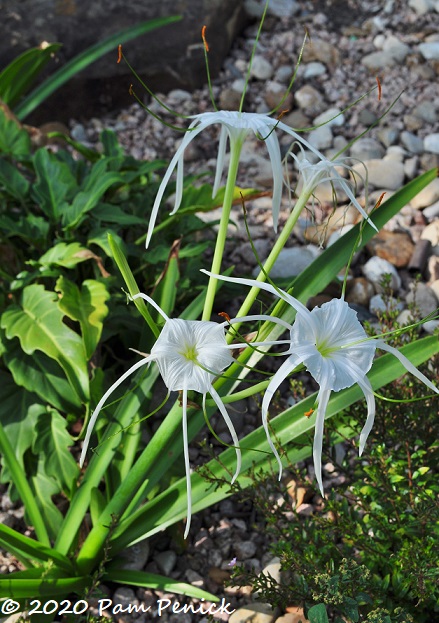
A tropical white spider lily
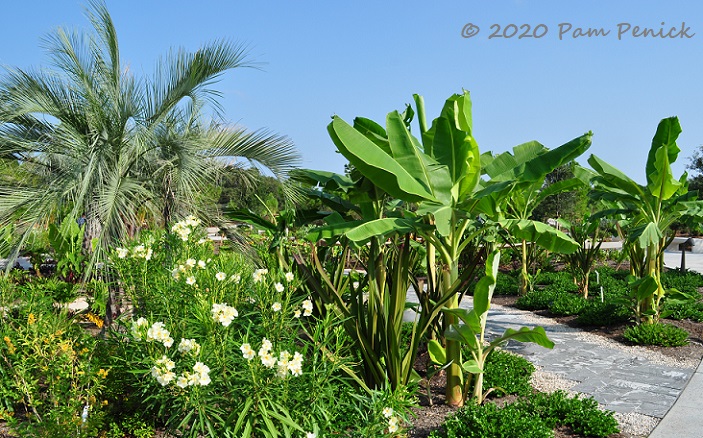
Bananas really create a tropical mood, seen here with white oleander and a silvery palm.
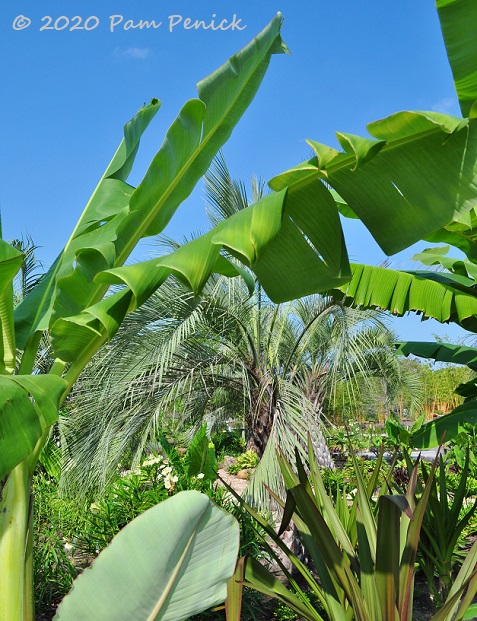
Foliage power!
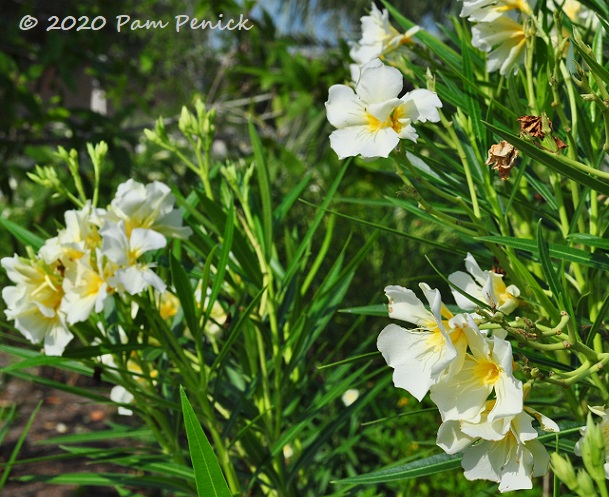
Oleander’s beautiful flowers
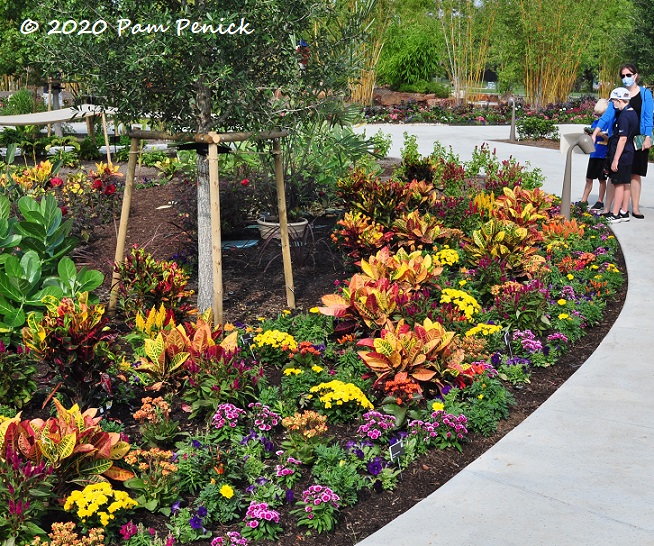
Ka-pow color from tropical shrub ‘Petra’ croton mixed with yellow chrysanthemums, peppers, and other annuals.
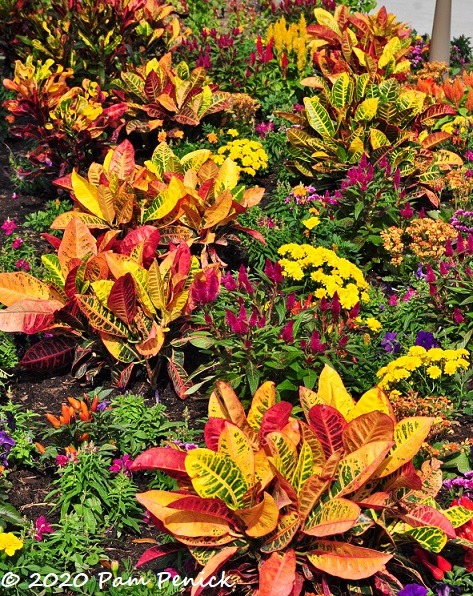
The colors of fall, way earlier than any trees would turn in Houston.
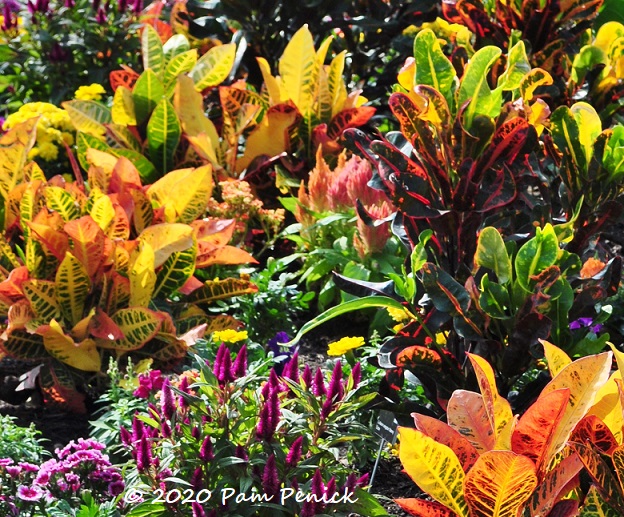
And that’s a wrap for the first half of my tour. Up next: Cactus in Houston? Yes! An arid garden at Houston Botanic Garden surprises with agave and cactus, plus a grassy savanna, pollinator garden, and more in part 2 of my tour.
__________________________
Digging Deeper
Come learn about gardening and design at Garden Spark! I organize in-person talks by inspiring designers, landscape architects, authors, and gardeners a few times a year in Austin. These are limited-attendance events that sell out quickly, so join the Garden Spark email list to be notified in advance; simply click this link and ask to be added. Season 8 kicks off in fall 2024. Stay tuned for more info!
All material © 2025 by Pam Penick for Digging. Unauthorized reproduction prohibited.


So pretty! Can’t wait to go next time I’m in Houston.
It’s so nice to have a new outdoor activity to do there, especially during covid times when being outdoors is the only safe option.
How fun to see it right at the start. They’ve done a very nice job, and I’ll be interested to see the progress over the years. And the upcoming part 2, as well!
I hope to have part 2 up tomorrow morning. Lots more garden goodness to share from HBG!
Thank you for such a great review
I’m glad you enjoyed it, Kemal.
It looks like a great garden. I love those plant pockets in the wall! Such a clever way to break up that long expanse of hardscape.
I loved those. Such an interesting feature and a way to add a little more garden to the garden.
How delicious! I love the design, especially those plant pockets in the wall. Great introduction to a new garden. I am eager to explore it.
A new botanic garden like Houston’s is a bright spot in an otherwise bummer of a year. I’m glad you enjoyed the tour, Ginny.
Really really lovely. Your images are super. Great plantings that will become even more exciting with time. The architectural elements are wonderful. Followed the Inhabit link to see who designed what. Amazed Houston has not had a botanic garden. They have so many great cultural offerings. Will be a treat to visit HBG. We always deliberately travel to Houston in the cooler seasons heh. Look forward to seeing your part 2. Desert plants in Houston, can’t miss that! 🙂
It’s pretty crazy to see cactus in Houston! I’ll have Part 2 up tomorrow morning, and I hope you enjoy your visit when you go. Amazingly, it was in the upper 70s there last Saturday when I visited — in September! Unheard of.
I was so glad to see that you did a review on the Houston Botanical Garden. My husband and I will be visiting it soon (we live in Houston, in Clear Lake City area) now that we’ve gotten a couple of issues settled and Beta has gone on its way. Next week will probably be a good time – there is a cold front that is suppose to come in and provide relief from 95+ days! Thank you for the great photos and for bringing different plants to our attention. I’ll be looking out for them! Looking forward to your Part 2. I am really interested in what succulents and cactus they have. For that matter, we will soon be doing some serious landscaping in our new home and want to see what types of plants the Botanical Garden has.
Thanks for your comment, Nancy. It’s a great getaway now that days are getting cooler. It was in the upper 70s last Saturday when I visited — in September. Crazy!
A warning about some mangaves. The same beetle that has killed several of my Agave ovatifolia by laying eggs and the larvae eating the heart of the plant, just took out a mature “Falling Waters’ mangave. If you think about the parentage of the “Falling Waters’ mangave you can see where this could be a possibility. I have other species of agaves, manfredas, and mangaves unaffected so far.
The evil weevil strikes again! The agave weevil killed a beautiful ‘Macho Mocha’ mangave of mine about 13 years ago. I’ve never forgiven it. I’m sorry about your ‘Falling Waters’ loss. Whereabouts are you growing them, James? It sounds like you have a collection going on.
Just south of DFW.
Where did you find that mangave, if you don’t mind my asking? 🙂
I have ordered a variety of mangaves from Plant Delights Nursery online. Before they closed I ordered manfreda varieties from Yucca Do. The Agave ovatifolias that were killed by the weevil I went to the Yucca Do nursery in Giddings probably around 2009 to purchase them. They were large when I purchased them and had become massive. They probably would have flowered within a couple of years but it still hurt to lose them, they were so sculptural. The weevil moved across my driveway from one island bed to another to get the ‘Falling Waters’ mangave. It by passed some other mangaves and manfredas. I am curious about the selection process of the weevil.
James, I treat my biggest, most valuable agaves, mangaves, and Yucca rostratas (so expensive to replace, and sculptural too) with a once-a-year systemic drench around the root zone, which protects them from the weevil. I neglected to treat a big, beautiful whale’s tongue agave in my neighbor’s garden that I’d planted for her, and the weevils killed it a year ago. It just about broke my heart.
Well that was fun. SO interesting to see a botanical garden in it’s early days. So, why are cycads not normally grown in Houston? (probably a dumb question but hey, I come from a no-cycad area too (winter cold) so I don’t know!)
Yeah, I don’t know what’s up with that poor-looking cycad. I live in Houston and cycads are grown everywhere here. I can only guess that pathetic looking one is some other species of cycad? The one that grows here does so very well. While they are dramatic, especially in a tropical or subtropical garden, I wouldn’t have one. They are hellacious to work around in a bed. Every thing about them pricks you. If they are in the bed you are working in, you can’t avoid them! I know they are nice-looking and expensive, but it gets old trying to keep a bed up when you know you are going to have pricks all over you!
@NancyBunyard – I agree, this must be some other sort of cycad. It looks like a dioon to me, but that grows just fine in Austin, so it should in Houston too. Maybe it just isn’t happy for some other reason, and that’s the standard sign they put out when they’re waiting to see if a plant will recover.
@DangerGarden – The strange thing is, cycads ARE grown widely in Houston. At least the traditional sago palm. I wish I could have found a label for this one. It looks like a dioon, which I would think would do fine there too.